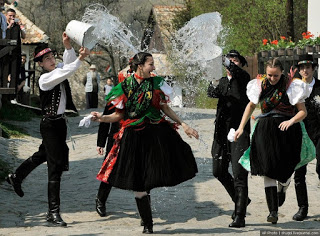Celebrating Easter
 Six of the Most Interesting Easter traditions from all around the world
Six of the Most Interesting Easter traditions from all around the worldNot everyone goes hunting for eggs on Easter Sunday.
Kids in the U.S. grow up expecting a delivery of eggs and candy from the Easter bunny each year, but it may seem odd to an outsider. Brought to this country by German immigrants in the 1700s, the practice is rooted in the belief that rabbits and eggs symbolize fertility and rebirth. While this may be the norm in America, however, other cultures have their own, unique Easter celebrations.
 1.Finland
1.Finland Children in this Scandinavian country go begging in the streets with sooty faces and scarves around their heads, carrying broomsticks, coffeepots and bunches of willow twigs. In some parts of Western Finland, people burn bonfires on Easter Sunday, a Nordic tradition stemming from the belief that the flames ward off witches who fly around on brooms between Good Friday and Easter Sunday.

2.Haux, France
Don't forget a fork if you're in this southern French town on Easter Monday. Each year a giant omelet is served up in the town's main square. And when we say giant, we mean giant: The omelet uses more than 4,500 eggs and feeds up to 1,000 people. The story goes, when Napoleon and his army were traveling through the south of France, they stopped in a small town and ate omelets. Napoleon liked his so much that he ordered the townspeople to gather their eggs and make a giant omelet for his army the next day.
 3.Corfu, Greece
3.Corfu, Greece On the morning of Holy Saturday, the traditional "Pot Throwing" takes place on the Greek island of Corfu: People throw pots, pans and other earthenware out of their windows, smashing them on the street. Some say the custom derives from the Venetians, who on New Year's Day used to throw out all of their old items. Others believe the throwing of the pots welcomes spring, symbolizing the new crops that will be gathered in the new pots.
 4.Rome, Italy
4.Rome, ItalyOn Good Friday the Pope commemorates the Via Crucis (Way of the Cross) at the Colosseum: A huge cross with burning torches illuminates the sky as the 14 Stations of the Cross are described in several languages. Mass is celebrated on the evening of Holy Saturday, and on Easter Sunday, thousands of visitors congregate in St. Peter's Square to await the Pope's blessing from the church's balcony, known as "Urbi et Orbi" ("To the City and to the World").
 5.Jerusalem, Israel
5.Jerusalem, IsraelTaking place in the city where it is believed Jesus was crucified, Christians celebrate Good Friday by walking the same path Jesus did on the day he was nailed to the cross. Taking note of his pain that fateful day, some of those who participate carry a cross with them in remembrance. On Easter Sunday, many pilgrims attend a church service at Garden Tomb—the area that it is believed Jesus was buried.
 6.Hungary
6.Hungary"Sprinkling," a popular Hungarian Easter tradition, is observed on Easter Monday, which is also known as "Ducking Monday." Boys playfully sprinkle perfume or perfumed water on girls. Young men used to pour buckets of water over young women's heads, but now they spray perfume, cologne or just plain water, and ask for a kiss. People used to believe that water had a cleaning, healing and fertility-inducing effect.
source: http://www.womansday.com
PRACTICE
A. In which place…
1.do the people say hello to spring by destroying pottery and artifacts?
2.do the people assembly to a central avenue to celebrate spiritually the resurrection?
3.do the people purify themselves by performing a kind of “ice-bucket challenge”?
4.do the people revive the passions of Christ by following his steps?
5.do the children disguise themselves and roaming in the roads?
6.do the children expect to receive their chocolate rabbits and eggs?
7.do the people light fires to keep away the evil spirits?
8.do the people perform an egg recipe in huge dimensions?
B. Match the pictures with the appropriate country:







Comments
Post a Comment